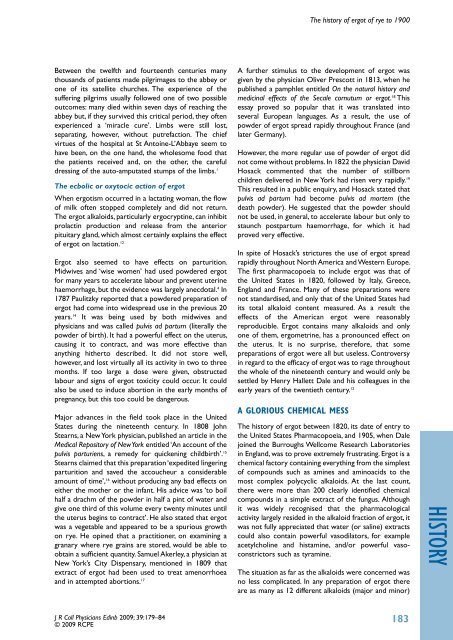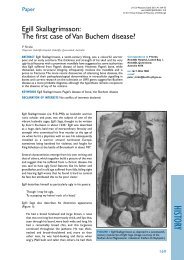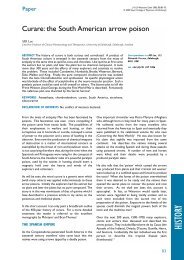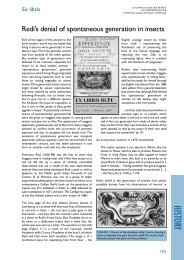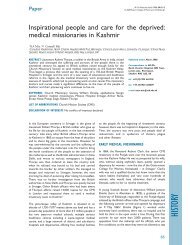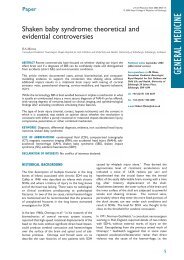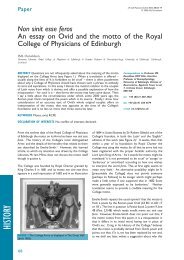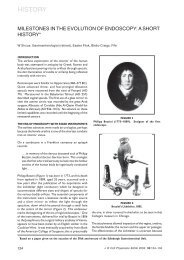The history of ergot of rye (Claviceps purpurea) I: From antiquity to ...
The history of ergot of rye (Claviceps purpurea) I: From antiquity to ...
The history of ergot of rye (Claviceps purpurea) I: From antiquity to ...
Create successful ePaper yourself
Turn your PDF publications into a flip-book with our unique Google optimized e-Paper software.
Between the twelfth and fourteenth centuries many<br />
thousands <strong>of</strong> patients made pilgrimages <strong>to</strong> the abbey or<br />
one <strong>of</strong> its satellite churches. <strong>The</strong> experience <strong>of</strong> the<br />
suffering pilgrims usually followed one <strong>of</strong> two possible<br />
outcomes: many died within seven days <strong>of</strong> reaching the<br />
abbey but, if they survived this critical period, they <strong>of</strong>ten<br />
experienced a ‘miracle cure’. Limbs were still lost,<br />
separating, however, without putrefaction. <strong>The</strong> chief<br />
virtues <strong>of</strong> the hospital at St An<strong>to</strong>ine-L’Abbaye seem <strong>to</strong><br />
have been, on the one hand, the wholesome food that<br />
the patients received and, on the other, the careful<br />
dressing <strong>of</strong> the au<strong>to</strong>-amputated stumps <strong>of</strong> the limbs. 1<br />
<strong>The</strong> ecbolic or oxy<strong>to</strong>cic action <strong>of</strong> <strong>ergot</strong><br />
When <strong>ergot</strong>ism occurred in a lactating woman, the flow<br />
<strong>of</strong> milk <strong>of</strong>ten s<strong>to</strong>pped completely and did not return.<br />
<strong>The</strong> <strong>ergot</strong> alkaloids, particularly ergocryptine, can inhibit<br />
prolactin production and release from the anterior<br />
pituitary gland, which almost certainly explains the effect<br />
<strong>of</strong> <strong>ergot</strong> on lactation. 12<br />
Ergot also seemed <strong>to</strong> have effects on parturition.<br />
Midwives and ‘wise women’ had used powdered <strong>ergot</strong><br />
for many years <strong>to</strong> accelerate labour and prevent uterine<br />
haemorrhage, but the evidence was largely anecdotal. 4 In<br />
1787 Paulitzky reported that a powdered preparation <strong>of</strong><br />
<strong>ergot</strong> had come in<strong>to</strong> widespread use in the previous 20<br />
years. 14 It was being used by both midwives and<br />
physicians and was called pulvis ad partum (literally the<br />
powder <strong>of</strong> birth). It had a powerful effect on the uterus,<br />
causing it <strong>to</strong> contract, and was more effective than<br />
anything hither<strong>to</strong> described. It did not s<strong>to</strong>re well,<br />
however, and lost virtually all its activity in two <strong>to</strong> three<br />
months. If <strong>to</strong>o large a dose were given, obstructed<br />
labour and signs <strong>of</strong> <strong>ergot</strong> <strong>to</strong>xicity could occur. It could<br />
also be used <strong>to</strong> induce abortion in the early months <strong>of</strong><br />
pregnancy, but this <strong>to</strong>o could be dangerous.<br />
Major advances in the field <strong>to</strong>ok place in the United<br />
States during the nineteenth century. In 1808 John<br />
Stearns, a New York physician, published an article in the<br />
Medical Reposi<strong>to</strong>ry <strong>of</strong> New York entitled ‘An account <strong>of</strong> the<br />
pulvis parturiens, a remedy for quickening childbirth’. 15<br />
Stearns claimed that this preparation ‘expedited lingering<br />
parturition and saved the accoucheur a considerable<br />
amount <strong>of</strong> time’, 16 without producing any bad effects on<br />
either the mother or the infant. His advice was ‘<strong>to</strong> boil<br />
half a drachm <strong>of</strong> the powder in half a pint <strong>of</strong> water and<br />
give one third <strong>of</strong> this volume every twenty minutes until<br />
the uterus begins <strong>to</strong> contract’. He also stated that <strong>ergot</strong><br />
was a vegetable and appeared <strong>to</strong> be a spurious growth<br />
on <strong>rye</strong>. He opined that a practitioner, on examining a<br />
granary where <strong>rye</strong> grains are s<strong>to</strong>red, would be able <strong>to</strong><br />
obtain a sufficient quantity. Samuel Akerley, a physician at<br />
New York’s City Dispensary, mentioned in 1809 that<br />
extract <strong>of</strong> <strong>ergot</strong> had been used <strong>to</strong> treat amenorrhoea<br />
and in attempted abortions. 17<br />
J R Coll Physicians Edinb 2009; 39:179–84<br />
© 2009 RCPE<br />
A further stimulus <strong>to</strong> the development <strong>of</strong> <strong>ergot</strong> was<br />
given by the physician Oliver Prescott in 1813, when he<br />
published a pamphlet entitled On the natural <strong>his<strong>to</strong>ry</strong> and<br />
medicinal effects <strong>of</strong> the Secale cornutum or <strong>ergot</strong>. 18 This<br />
essay proved so popular that it was translated in<strong>to</strong><br />
several European languages. As a result, the use <strong>of</strong><br />
powder <strong>of</strong> <strong>ergot</strong> spread rapidly throughout France (and<br />
later Germany).<br />
However, the more regular use <strong>of</strong> powder <strong>of</strong> <strong>ergot</strong> did<br />
not come without problems. In 1822 the physician David<br />
Hosack commented that the number <strong>of</strong> stillborn<br />
children delivered in New York had risen very rapidly. 19<br />
This resulted in a public enquiry, and Hosack stated that<br />
pulvis ad partum had become pulvis ad mortem (the<br />
death powder). He suggested that the powder should<br />
not be used, in general, <strong>to</strong> accelerate labour but only <strong>to</strong><br />
staunch postpartum haemorrhage, for which it had<br />
proved very effective.<br />
In spite <strong>of</strong> Hosack’s strictures the use <strong>of</strong> <strong>ergot</strong> spread<br />
rapidly throughout North America and Western Europe.<br />
<strong>The</strong> first pharmacopoeia <strong>to</strong> include <strong>ergot</strong> was that <strong>of</strong><br />
the United States in 1820, followed by Italy, Greece,<br />
England and France. Many <strong>of</strong> these preparations were<br />
not standardised, and only that <strong>of</strong> the United States had<br />
its <strong>to</strong>tal alkaloid content measured. As a result the<br />
effects <strong>of</strong> the American <strong>ergot</strong> were reasonably<br />
reproducible. Ergot contains many alkaloids and only<br />
one <strong>of</strong> them, ergometrine, has a pronounced effect on<br />
the uterus. It is no surprise, therefore, that some<br />
preparations <strong>of</strong> <strong>ergot</strong> were all but useless. Controversy<br />
in regard <strong>to</strong> the efficacy <strong>of</strong> <strong>ergot</strong> was <strong>to</strong> rage throughout<br />
the whole <strong>of</strong> the nineteenth century and would only be<br />
settled by Henry Hallett Dale and his colleagues in the<br />
early years <strong>of</strong> the twentieth century. 12<br />
A glORIOUS CheMICAl MeSS<br />
<strong>The</strong> <strong>his<strong>to</strong>ry</strong> <strong>of</strong> <strong>ergot</strong> <strong>of</strong> <strong>rye</strong> <strong>to</strong> 1900<br />
<strong>The</strong> <strong>his<strong>to</strong>ry</strong> <strong>of</strong> <strong>ergot</strong> between 1820, its date <strong>of</strong> entry <strong>to</strong><br />
the United States Pharmacopoeia, and 1905, when Dale<br />
joined the Burroughs Wellcome Research Labora<strong>to</strong>ries<br />
in England, was <strong>to</strong> prove extremely frustrating. Ergot is a<br />
chemical fac<strong>to</strong>ry containing everything from the simplest<br />
<strong>of</strong> compounds such as amines and aminoacids <strong>to</strong> the<br />
most complex polycyclic alkaloids. At the last count,<br />
there were more than 200 clearly identified chemical<br />
compounds in a simple extract <strong>of</strong> the fungus. Although<br />
it was widely recognised that the pharmacological<br />
activity largely resided in the alkaloid fraction <strong>of</strong> <strong>ergot</strong>, it<br />
was not fully appreciated that water (or saline) extracts<br />
could also contain powerful vasodila<strong>to</strong>rs, for example<br />
acetylcholine and histamine, and/or powerful vasoconstric<strong>to</strong>rs<br />
such as tyramine.<br />
<strong>The</strong> situation as far as the alkaloids were concerned was<br />
no less complicated. In any preparation <strong>of</strong> <strong>ergot</strong> there<br />
are as many as 12 different alkaloids (major and minor)<br />
183<br />
<strong>his<strong>to</strong>ry</strong>


